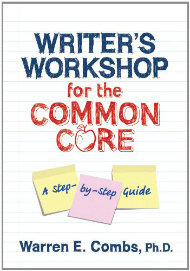Writer’s Workshop for the Common Core: A Step-by-Step Guide
Writer’s Workshop for the Common Core:
A Step-by-Step Guide
By Warren E. Combs, Ph.D.
(Routledge/Eye on Education, 2011 – Learn more)

As a classroom teacher who used writer’s workshop through the years, I was anxious to see how Dr. Warren Combs connected writer’s workshop and the Common Core State Standards. The back cover of Writer’s Workshop for the Common Core A Step-by-Step Guide indicates this book is a “step-by-step plan for aligning the writer’s workshop model to the Common Core Standards for elementary and middle grades.”

Writer’s Workshop concepts dominate
Dr. Combs, recognized as an expert in teaching writing, stresses the need for authentic learning in the Introduction. In Chapters 1-3 he addresses the Writing Cycle, “an instructional tool that solders the connection between learning (writer’s workshop) and testing (state writing tests).” The next chapters include instructional tools and strategies “that ease the stress of teaching writing.” Chapters 6-11 continue Combs’s Writing Cycle with a pacing guide for creating first drafts. Issues of proofreading, scoring, mock test writing prompts, and publication are discussed in the remaining four chapters.
While there are numerous references to the Common Core State Standards, the first standard does not appear until Chapter 3, “A First Look at the Writing Cycle.” The main idea of this chapter appears to be six key practices of the Writing Cycle. According to the author, the Writing Cycle serves as an instructional scaffold. When done correctly, it appears to fit into a nine-week grading period focusing “on one step of the writing process each week.”
Chapter 4, “Kindling Innate Abilities,” introduces eight terms which Combs believes help students “develop the capacity to build knowledge on a subject… [from] literary and informational sources.” (p. 23) The author suggests that these eight words help students to grow as writers: voice, pictures, flow, invite, model, write, look, and learn. He then follows with the why for using these terms. His best advice to teachers comes on page 24: “Talk less, write more.”
Tracking the Elusive CC
“Analyze a Writing Prompt with Me” (Chapter 6) leads me to believe that College and Career Readiness Anchor Standards 2 and 4 will be discussed. However, the chapter seems to focus on My Assignment Page, a chart students complete to indicate how well they understand the assigned writing topic. By the end of the chapter, I couldn’t remember what standards the author was addressing. After looking back at the beginning of the chapter, I wasn’t sure I saw a connection.
Unfortunately, the layout of the book was not particularly reader friendly. For example, at the bottom of page 59, after reading a rather long sentence, the reader comes to a colon. One might expect to turn the page and see the list of Elements and Benefits the author has mentioned in the long sentence. Instead, on page 60 you find Figure 7.3 “Word Bank for Explaining a Process.” Keep looking! The Elements and Benefits that should follow the colon on page 59 are found on pages 61 and 62.
The sections labeled “Lesson with Scripting for …” or “Mini-Lesson with Scripting for …” appeared stilted at times. Perhaps if the student responses had been woven into the teacher’s script it would have sounded more like today’s classrooms. Throughout the book there are some nuggets for teaching writing (for example, Chapter 10: “Fine-Tune Leads and Closes with Me” and Chapter 12: “Proofread a Final Draft with Me”).
For teachers who want to learn more about writer’s workshop, Writer’s Workshop for the Common Core is a good choice, if sometimes a navigational challenge. The many charts Dr. Combs created to track student progress are available online. But, if you are a classroom teacher who wants to know more about teaching writing within a CCSS/Workshop frame, this is not the book for you.
Anne Anderson, finally got out of the 8th grade after 24 years and 9 weeks! She spent the next 9 years sharing her expertise in literacy and writing with K-12 teachers and administrators throughout the district. She credits National Writing Project and Poetry Alive! as turning points in her growth as a teacher. She now shares her expertise nationwide as an Educational Consultant and through her bi-monthly newsletter Spotlight on Success.

































